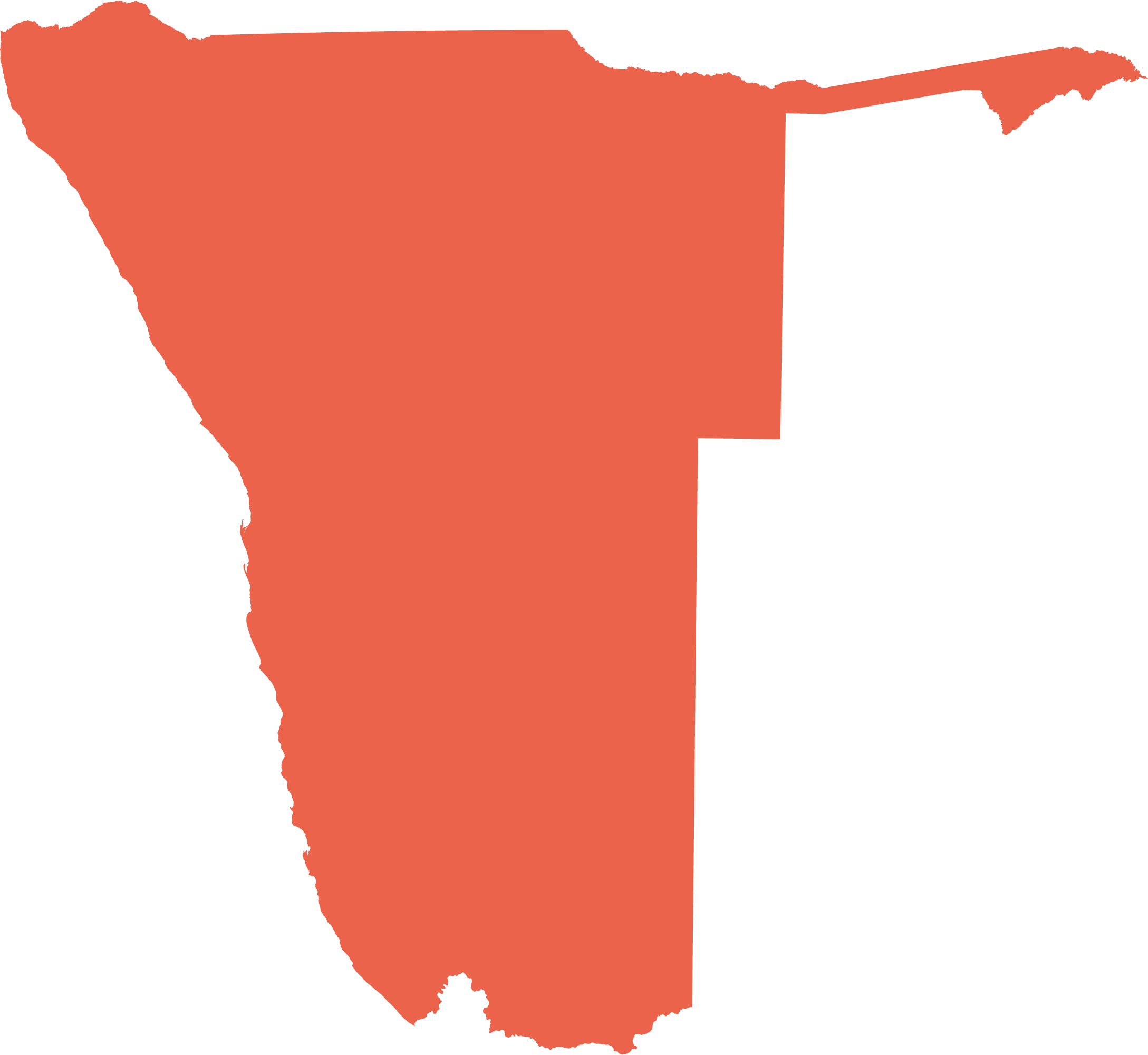The bigger picture
Many creatures undertake extensive migrations in the air and in the oceans, following a variety of cues to navigate thousands of kilometres. This section provides a few examples of animals that visit Namibia while undertaking long migratory journeys to find their optimal breeding and feeding sites across the earth.
These long-distance movements can now be tracked due to revolutionary improvements in methods of collecting data using tiny transmitters. Small in size and weight (just a few grams in some cases), these devices allow scientists to monitor animal movements around the globe.
7.56 Global migrations of six migratory bird species
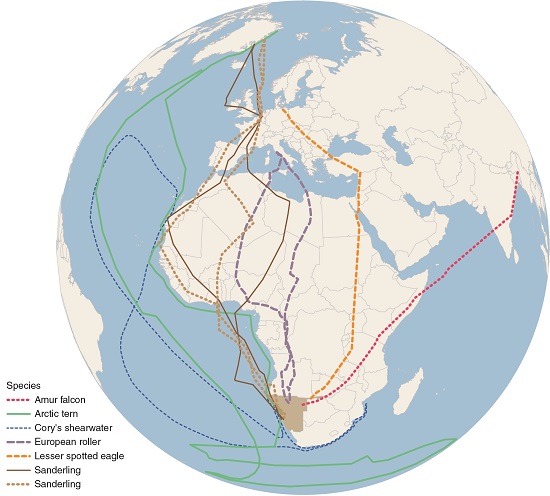

Photo: E Chernetsova
Arctic tern (Sterna paradisaea)
Arctic terns (Sterna paradisaea), small birds of the sea and shore that weigh about 100 grams, fly from the Arctic Circle across the North Atlantic and down along the west coast of Africa, and spend the southern hemisphere summer in the Antarctic Circle. They can be seen along the Namibian coast from about November to February. Each tern covers about 60,000–80,000 kilometres each year during its southbound and northbound migrations. This is the longest migration of any species worldwide.78

Photo: B Meyburg
Lesser spotted eagle (Clanga pomarina) with transmitter
Lesser spotted eagles (Clanga pomarina) breed in eastern Europe and migrate to Africa when they are not breeding; they are usually seen in northeastern Namibia from November to March, feeding on termites, grasshoppers and frogs. The path shown in the map was taken by an adult bird from Germany that covered 9,000 kilometres over a period of about eight weeks. It spent four months in southern Africa, then made its way back along an almost identical route to its breeding grounds.79
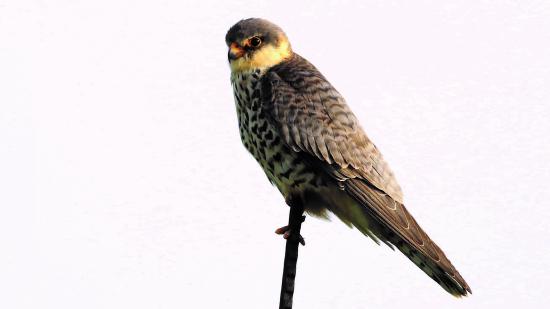
Photo: D Keats
Amur falcon (Falco amurensis)
The Amur falcon (Falco amurensis) is a small bird of prey weighing less than 200 grams. It commutes between China, where it breeds, and southern Africa each year. During its passage, the Amur falcon undertakes the longest over-water migration of any bird of prey, flying about 4,000 kilometres between India and Africa over the Indian Ocean.80

Photo: J Mendelsohn
Cory's shearwater (Calonectris borealis)
Cory's shearwaters (Calonectris borealis) are medium-sized seabirds that breed on the Canary Islands, and spend about half the year over the South and North Atlantic oceans. They pass along the coast of southern Africa in summer, concentrating to feed along the edge of the continental shelf. They cover up to 13,000 kilometres without major breaks, flying and catching fish and squid as they go. Daily movements are up to 650 kilometres.82

Photo: R de Klerk
European roller (Coracias garrulus)
Rollers are brightly coloured, medium-sized birds and the European roller (Coracias garrulus) shares its time between warm, dry areas in northern Africa and Europe, and southern Africa. One individual was recently tracked from its breeding site near Rome, Italy, to just south of Etosha and back. Each journey took a little over two months, lingering in certain places to feed and taking about a week to cross the Sahara in each direction. Flying was mostly done at night, with up to 14 hours non-stop over the Sahara and the Mediterranean Sea.81
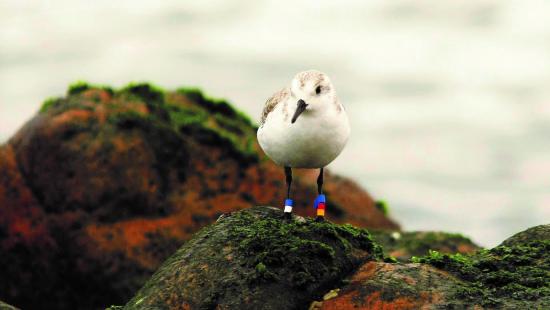
Photo: R Portas
Sanderling (Calidris alba)
Sanderlings (Calidris alba) weigh less than 80 grams. They breed in the High Arctic in the northern hemisphere summer, and then disperse annually to temperate and tropical coasts across much of the world, covering distances of 4,000–22,000 kilometres a year. In the southern hemisphere summer, thousands of sanderlings gather in the wetlands of Walvis Bay and Sandwich Harbour. In terms of the total number of wading shorebirds supported, Walvis Bay is the most important wetland in southern Africa and probably one of the three most important coastal wetlands in Africa. It is a vital refuelling station for sanderlings which spend months fattening up on invertebrates found in the muddy lagoon.83
7.57 Regional migrations of four bird species
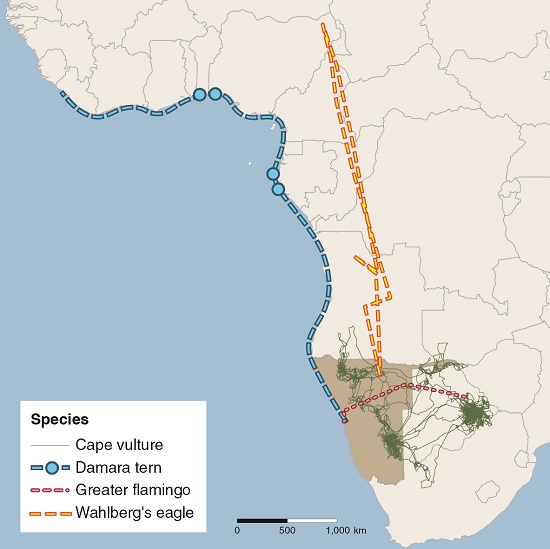
Wahlberg's eagles (Hieraaetus wahlbergi) migrate each year between their breeding areas in southern Africa and woodlands north of the equator. Many other birds do the same, such as species of swallows, swifts and cuckoos. The path shown in the map is of a bird that flew 3,520 kilometres from Tsintsabis near Tsumeb to northeastern Nigeria. It spent four months there before its return journey south, which ended close to where it was first found, and where it bred again.84
Young Cape vultures (Gyps coprotheres) move widely before settling down in a relatively restricted area. The path of this young female Cape vulture over 63 months shows how she favoured certain foraging areas – presumably where animal carcasses were easily available – in western Omusati Region, southeastern Namibia, and eastern and northern Botswana. She also journeyed into parts of Angola, Zambia, Zimbabwe and South Africa. Such movements are achieved on thermals of warm air up to 1,000 metres above the ground. When foraging, Cape vultures fly lower to search the ground thoroughly.85
Greater and lesser flamingos are a well-known sight at the Walvis Bay lagoon. They breed on inland pans such as Etosha, and Makgadikgadi Pan in Botswana, when these pans hold water. How they time these movements in relation to rain filling the pans is not known. The map shows the path of a greater flamingo that left Makgadikgadi Pan, stopped over at Nyae Nyae Pans, and then continued to the coast, flying 1,230 kilometres over two consecutive nights. Some of the 1.1 million lesser flamingos that bred at Etosha in 1971, a year of high rainfall in southern Africa, may have originated from East Africa.86
The Damara tern (Sternula balaenarum) is Africa's smallest breeding tern. It breeds on barren salt pans and gravel plains along the Namib coast, then all but a small fraction leave southwestern Africa in about April for feeding grounds in West Africa. The birds move northwards along the Namibian coast, coalescing into larger flocks which then migrate northward to overwinter in countries such as Gabon, Nigeria and Benin, and even as far as Liberia and Senegal. They return to their breeding grounds in September and October. The mapped path is hypothetical, but it shows where birds ringed in Namibia and South Africa have been recorded on the West African coast, at least 4,000 kilometres from their breeding grounds.87

Photo: J Mendelsohn
The aerial of a transmitter is visible on the back of this Cape vulture (Gyps coprotheres).

Photo: JP Roux
Damara tern (Sternula balaenarum) with identification ring
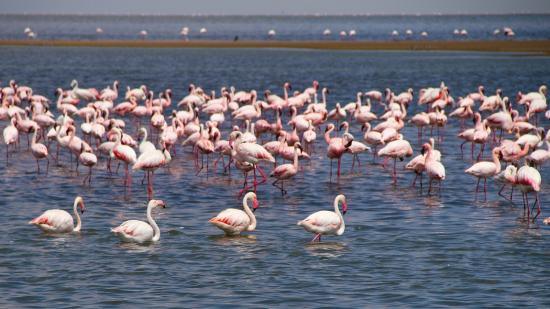
Photo: C Begley
Flamingos at the lagoon in Walvis Bay

Photo: J Mendelsohn
Wahlberg's eagle (Hieraaetus wahlbergi)
